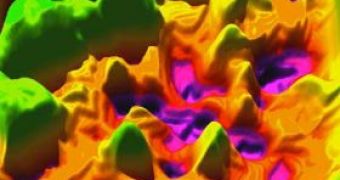Bones are one of the toughest organic tissues and this enabled them to fossilize very well. They are also the trick behind the evolution of vertebrates.
Now a MIT team has made a first-of-its-kind analysis of the bone's mechanical properties, in an attempt to explain their amazing biomechanical properties. The researchers focused on bones' fundamental building block: a protein called collagen embedded with tiny nanoparticles of mineral, of tens of nanometers (a human hair, for example, is 80,000 nanometers in diameter).
"If you want to investigate the origins of the strength and toughness of a material, you probe it at smaller and smaller length scales. The insights gained from the work could also lead to the creation of new, tougher materials," said co-author Subra Suresh, Ford Professor of Engineering, with appointments in materials science and engineering, biological engineering, mechanical engineering and the Harvard-MIT Division of Health Sciences and Technology.
"The structure, quality and integrity of bone change dramatically with age and disease, hence understanding the origins of the mechanical properties of this major load-bearing, structural tissue in our body is extremely important from a medical standpoint," said lead researcher Christine Ortiz, associate professor of materials science and engineering.
Using a molecular force probe, which analyzes an extremely small probe, the team transposed the stiffness of bovine shin bone into colorful, two-dimensional contour maps. The bone's mechanical traits were found to change significantly within a distance of just two micrometers (thousandths of a meter) wide.
As many diseases or aging inflict changes in bone structure, this non-uniformity of bone's mechanical traits at very small length scales could deliver early improved diagnoses if specific nanoscale patterns of stiffness within bone structure were linked to them. Computer models showed that the non-uniform stiffness patterns enhance the bone's ability to absorb energy.
"We tend to think that if a material is non-uniform, it is not as tough. Our thesis is that nature, by making bones non-uniform at extremely small length scales over the course of millions of years of evolution, has designed bone to be able to absorb much more energy than a uniform material with the same properties." said Suresh.
"Cells sense and respond to stresses in their environment. Since different local mechanical properties in bone change the magnitude of stresses around the cell, the cells' behavior can be altered in response, thereby affecting the health of the tissue." said Ortiz.
This research could inspire new improved structural composites imitating the bones' structure that enable them to avoid fractures. There is already a new class of nanocomposites made of a polymer or metallic matrix filled with nanoscale particles located randomly or periodically.
"There may be ways to disperse particles non-uniformly that may lead to improved material toughness," Suresh said.

 14 DAY TRIAL //
14 DAY TRIAL //